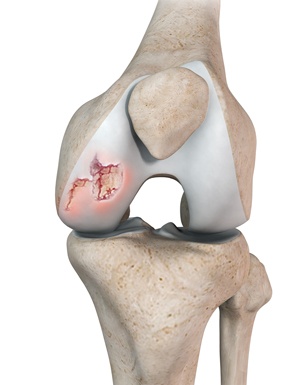
What is an Articular Cartilage Defect?
The articular or hyaline cartilage is the tissue lining the surface of the two bones in the knee joint. Cartilage helps the bones move smoothly against each other and can withstand the weight of your body during activities such as running and jumping. Articular cartilage does not have a direct blood supply to it, so has less capacity to repair itself. Once the cartilage is torn it will not heal easily and can lead to degeneration of the articular surface, leading to the development of osteoarthritis.
Causes of Articular Cartilage Defects
The damage of the articular cartilage can affect you regardless of your age. It can be damaged by trauma such as accidents, mechanical injury such as a fall or from degenerative joint disease (osteoarthritis) occurring in older people.
Symptoms of Articular Cartilage Defects
The symptoms of articular cartilage damage include joint pain, swelling, stiffness and a decrease in the range of motion of the knee.
Treatment of Articular Cartilage Defects
The damaged cartilage needs to be replaced with healthy cartilage. The procedure is known as cartilage replacement. It is a surgical procedure performed to replace the worn-out cartilage and is usually performed to treat small areas of cartilage damage usually caused by sports or traumatic injuries. It is not indicated for advanced arthritis of the knee.
Cartilage replacement helps relieve pain, restore normal function, and can delay or prevent the onset of arthritis. The goal of cartilage replacement procedures is to stimulate the growth of new hyaline cartilage. Various arthroscopic procedures involved in cartilage replacement include:
- Microfracture
- Drilling
- Abrasion arthroplasty
- Autologous chondrocyte implantation (ACI)
- Osteochondral autograft transplantation
Related Topics
- Patellar Instability
- Multiligament Instability
- Patellofemoral Instability
- Posterolateral Instability
- Knee Arthritis
- Knee Osteoarthritis
- Knee Injury
- Knee Pain
- Anterior Knee Pain
- Meniscal Tears
- Runners Knee
- Jumpers Knee
- Unstable Knee
- Knee Sprain
- MCL Sprains
- ACL Tears
- MCL Tears
- Meniscal Injuries
- PCL Injuries
- Ligament Injuries
- Knee Fracture
- Fractures of the Tibia
- Patella Fracture
- Tibial Shaft Fracture
- Kneecap Bursitis
- Chondral or Articular Cartilage Defects
- Quadriceps Tendon Rupture
- Patellar Tendon Rupture
- Lateral Meniscus Syndrome
- Osteonecrosis of the Knee
- Knee Angular Deformities
- Osteochondral Defect of the Knee
- Articular Cartilage Injury
- Goosefoot Bursitis of the Knee
- Iliotibial Band Syndrome
- Bowed Legs
- Recurrent Patella Dislocation
- Osteochondritis Dissecans of the Knee
- Chondromalacia Patella
- Patellar Tendinitis
- Knee Sports Injuries
- Multiligament Knee Injuries
- Women and ACL Injuries
- Medial Meniscus Syndrome
- Tibial Plateau Fracture
- Tibial Eminence Fractures
- Loose Bodies in the Knee
- Osgood Schlatter Disease
- Patellar Dislocation/Patellofemoral Dislocation








